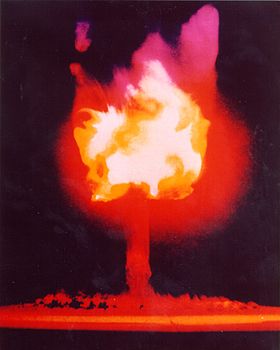Operation Ranger
Appearance
| Operation Ranger | |
|---|---|
 Ranger Fox | |
| Information | |
| Country | United States |
| Test site | Nevada Test Site |
| Period | January - February 1951 |
| Number of tests | 5 |
| Test type | Atmospheric tests |
| Device type | Fission |
| Max. yield | 22 kilotons of TNT (92 TJ) |
| Test chronology | |
Operation Ranger was the fourth American nuclear test series. It was conducted in 1951 and was the first series to be carried out at the Nevada Test Site.[1] All the bombs were dropped by B-50 bombers and exploded in the open air over Frenchman Flat (Area 5).
These tests centered on the practicality of developing a second generation of nuclear weapons using smaller amounts of valuable nuclear materials. They were planned under the name Operation Faust.
Preceded by Sandstone, followed by Greenhouse.| Test Name | Date | Location | Yield | Note |
|---|---|---|---|---|
| Able | 27 January 1951 | Nevada Test Site | .5 kilotons | Testing compression against critical mass as inspired by the Demon core. |
| Baker | 28 January 1951 | Nevada Test Site | 8 kilotons | First use of the TOM initiator[2]. |
| Easy | 1 February 1951 | Nevada Test Site | 1 kiloton | |
| Baker 2 | 2 February 1951 | Nevada Test Site | 8 kilotons | |
| Fox | 6 February 1951 | Nevada Test Site | 22 kilotons |
Notes
- ^ Hacker, Barton C (1994). Elements of Controversy: The Atomic Energy Commission and Radiation Safety in Nuclear Weapons Testing 1947-1974. University of California Press. p. 44. ISBN 0-520-08323-7. Retrieved 2012-01-03.
- ^ http://www.stealthskater.com/Documents/Nuke_16.pdf
External links
- The short film Nuclear Test Film - Operation Ranger, Operation Buster/Jangle (1951) is available for free viewing and download at the Internet Archive.
Wikimedia Commons has media related to Operation Ranger.
